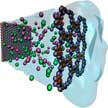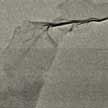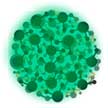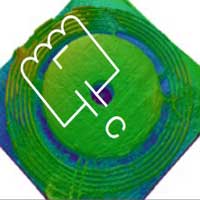Showing Spotlights 609 - 616 of 2879 in category All (newest first):
 Reverse osmosis (RO) is one of the most effective desalination technologies for producing freshwater from seawater. The reverse osmosis membrane water reclamation processes is very energy intensive - not exactly an advantage given the rising cost of energy and the negative climate impact of fossil fuels. In a new study, researchers found that metal-organic frameworks (MOF) allow higher water flux compared to other 2D materials while rejecting almost 100% of unwanted ions.
Reverse osmosis (RO) is one of the most effective desalination technologies for producing freshwater from seawater. The reverse osmosis membrane water reclamation processes is very energy intensive - not exactly an advantage given the rising cost of energy and the negative climate impact of fossil fuels. In a new study, researchers found that metal-organic frameworks (MOF) allow higher water flux compared to other 2D materials while rejecting almost 100% of unwanted ions.
Dec 11th, 2019
 Nanoengineering is a branch of engineering that exploits the unique properties of nanomaterials - their size and quantum effects - and the interaction between these materials, in order to design and manufacture novel structures and devices that possess entirely new functionality and capabilities, which are not obtainable by macroscale engineering. The book 'Nanoengineering: The Skills and Tools Making Technology Invisible' puts a spotlight on some of the scientists who are pushing the boundaries of technology and it gives examples of their work and how they are advancing knowledge one little step at a time.
Nanoengineering is a branch of engineering that exploits the unique properties of nanomaterials - their size and quantum effects - and the interaction between these materials, in order to design and manufacture novel structures and devices that possess entirely new functionality and capabilities, which are not obtainable by macroscale engineering. The book 'Nanoengineering: The Skills and Tools Making Technology Invisible' puts a spotlight on some of the scientists who are pushing the boundaries of technology and it gives examples of their work and how they are advancing knowledge one little step at a time.
Dec 4th, 2019
 Researchers have produced graphene by molten carbonate electrolytic splitting of CO2 to a nano-thin carbon product (carbon nanoplatelets) comprised of 25 to 125 graphene layers, and subsequent electrochemical exfoliation of the nanoplatelets to graphene in a carbonate soluble aqueous solution. The sole products of the carbon dioxide electrolysis are straightforward: high yield carbon nanoplatelets and oxygen. The carbon nanoplatelets provide a thinner starting point than a conventional graphite reactant to facilitate electrochemical exfoliation.
Researchers have produced graphene by molten carbonate electrolytic splitting of CO2 to a nano-thin carbon product (carbon nanoplatelets) comprised of 25 to 125 graphene layers, and subsequent electrochemical exfoliation of the nanoplatelets to graphene in a carbonate soluble aqueous solution. The sole products of the carbon dioxide electrolysis are straightforward: high yield carbon nanoplatelets and oxygen. The carbon nanoplatelets provide a thinner starting point than a conventional graphite reactant to facilitate electrochemical exfoliation.
Dec 2nd, 2019
 Researchers have demonstrated the first large-scale flexible thermal flow sensor array on a thin-film. This flow sensor - based on a calorimetric sensing mechanism - can not only monitor flow intensity but also flow direction. More importantly, these sensors can be attached onto curved surfaces for real-time flow monitoring. Flow separation is a common phenomenon affecting aircraft, wind turbine blades, micro aerials, and underwater vehicles. Owing to its unsteady flow profile, such separation is usually undesirable because either the airfoil efficiency decreases or large pressure fluctuations emerge. Consequently, precise monitoring is crucial to reduce or even prevent the flow separation effect.
Researchers have demonstrated the first large-scale flexible thermal flow sensor array on a thin-film. This flow sensor - based on a calorimetric sensing mechanism - can not only monitor flow intensity but also flow direction. More importantly, these sensors can be attached onto curved surfaces for real-time flow monitoring. Flow separation is a common phenomenon affecting aircraft, wind turbine blades, micro aerials, and underwater vehicles. Owing to its unsteady flow profile, such separation is usually undesirable because either the airfoil efficiency decreases or large pressure fluctuations emerge. Consequently, precise monitoring is crucial to reduce or even prevent the flow separation effect.
Nov 26th, 2019
 The origin of early life and the basic building blocks such as DNA and RNA have been hypothesized to have resulted due to accumulation of precursors within hydrothermal vents. The thermal gradients result in the concentration of prebiotic molecules with the vents acting as reactors. Researchers have translated this concept of accumulation-mediated concentration to the micro- and nanoscale for intensified materials synthesis and genomics. Utilizing a laser-induced micro bubble trap, their strategy, termed as unified spatiotemporal synthesis and structuring (US3), combines the conventionally discrete aspects of synthesis and patterning.
The origin of early life and the basic building blocks such as DNA and RNA have been hypothesized to have resulted due to accumulation of precursors within hydrothermal vents. The thermal gradients result in the concentration of prebiotic molecules with the vents acting as reactors. Researchers have translated this concept of accumulation-mediated concentration to the micro- and nanoscale for intensified materials synthesis and genomics. Utilizing a laser-induced micro bubble trap, their strategy, termed as unified spatiotemporal synthesis and structuring (US3), combines the conventionally discrete aspects of synthesis and patterning.
Nov 19th, 2019
 Nanoparticles have shown a lot of promise in biomedical applications. However, accumulation of nanoparticles in the liver is a major concern, and may be one of the greatest barriers to the widespread adoption of nanoparticles in the clinic. This is especially true for metallic nanoparticles, since the long-term effects of their accumulation in the liver has not been widely studied.
A team of researchers has looked to nature for inspiration in solving this problem. They decided to use biliverdin, a bile pigment, as the building block for their nanoparticles.
Nanoparticles have shown a lot of promise in biomedical applications. However, accumulation of nanoparticles in the liver is a major concern, and may be one of the greatest barriers to the widespread adoption of nanoparticles in the clinic. This is especially true for metallic nanoparticles, since the long-term effects of their accumulation in the liver has not been widely studied.
A team of researchers has looked to nature for inspiration in solving this problem. They decided to use biliverdin, a bile pigment, as the building block for their nanoparticles.
Nov 18th, 2019
 Radio-frequency wireless sensors are essential components of smart objects and internet-of-things components. However, these passive microsensors suffer from poor quality of data and sensitivity due to the environments they operate in and the need for sensors with extremely small footprints. Researchers have recently shown that a wireless system locked to an exceptional point (EP) can enhance the sensitivity of passive wireless sensors in practical applications. New work has theoretically introduced and experimentally demonstrated a new class of parity-time-symmetric RF electronic and telemetric systems, which combine EPs with divergent points.
Radio-frequency wireless sensors are essential components of smart objects and internet-of-things components. However, these passive microsensors suffer from poor quality of data and sensitivity due to the environments they operate in and the need for sensors with extremely small footprints. Researchers have recently shown that a wireless system locked to an exceptional point (EP) can enhance the sensitivity of passive wireless sensors in practical applications. New work has theoretically introduced and experimentally demonstrated a new class of parity-time-symmetric RF electronic and telemetric systems, which combine EPs with divergent points.
Nov 12th, 2019
 The goal of the electronics industry has always been to build durable devices with stable performance that last a very long time. 'Transient electronics', however, are designed with the exact opposite goal: to dissolve harmlessly into their surroundings after functioning for a certain amount of time. The fabrication process and the in vivo powering of medical implants that are only made from biodegradable materials are two of the challenges associated with transient electronics. Researchers demonstrate wirelessly powered, frequency-selective magnesium microstructures as promising candidates to be used as power receiver, microheaters and triggering elements for biodegradable implantable medical devices.
The goal of the electronics industry has always been to build durable devices with stable performance that last a very long time. 'Transient electronics', however, are designed with the exact opposite goal: to dissolve harmlessly into their surroundings after functioning for a certain amount of time. The fabrication process and the in vivo powering of medical implants that are only made from biodegradable materials are two of the challenges associated with transient electronics. Researchers demonstrate wirelessly powered, frequency-selective magnesium microstructures as promising candidates to be used as power receiver, microheaters and triggering elements for biodegradable implantable medical devices.
Nov 11th, 2019
 Reverse osmosis (RO) is one of the most effective desalination technologies for producing freshwater from seawater. The reverse osmosis membrane water reclamation processes is very energy intensive - not exactly an advantage given the rising cost of energy and the negative climate impact of fossil fuels. In a new study, researchers found that metal-organic frameworks (MOF) allow higher water flux compared to other 2D materials while rejecting almost 100% of unwanted ions.
Reverse osmosis (RO) is one of the most effective desalination technologies for producing freshwater from seawater. The reverse osmosis membrane water reclamation processes is very energy intensive - not exactly an advantage given the rising cost of energy and the negative climate impact of fossil fuels. In a new study, researchers found that metal-organic frameworks (MOF) allow higher water flux compared to other 2D materials while rejecting almost 100% of unwanted ions.
 Subscribe to our Nanotechnology Spotlight feed
Subscribe to our Nanotechnology Spotlight feed





